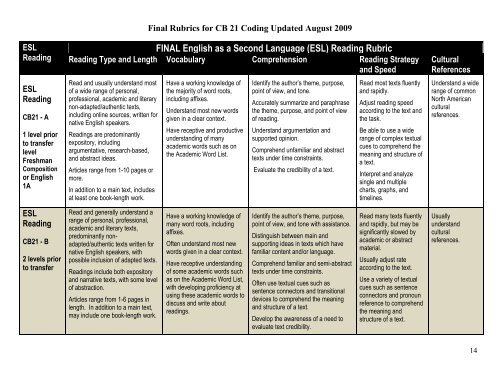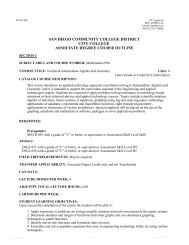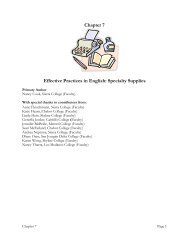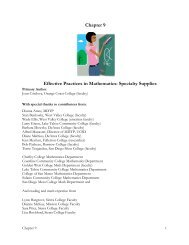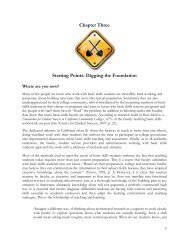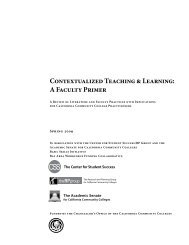CB 21 Rubric Only - Basic Skills Initiative
CB 21 Rubric Only - Basic Skills Initiative
CB 21 Rubric Only - Basic Skills Initiative
Create successful ePaper yourself
Turn your PDF publications into a flip-book with our unique Google optimized e-Paper software.
Final <strong>Rubric</strong>s for <strong>CB</strong> <strong>21</strong> Coding Updated August 2009<br />
FINAL English as a Second Language (ESL) Reading <strong>Rubric</strong><br />
ESL<br />
Reading Reading Type and Length Vocabulary Comprehension Reading Strategy<br />
and Speed<br />
ESL<br />
Reading<br />
<strong>CB</strong><strong>21</strong> - A<br />
1 level prior<br />
to transfer<br />
level<br />
Freshman<br />
Composition<br />
or English<br />
1A<br />
Read and usually understand most<br />
of a wide range of personal,<br />
professional, academic and literary<br />
non-adapted/authentic texts,<br />
including online sources, written for<br />
native English speakers.<br />
Readings are predominantly<br />
expository, including<br />
argumentative, research-based,<br />
and abstract ideas.<br />
Articles range from 1-10 pages or<br />
more.<br />
In addition to a main text, includes<br />
at least one book-length work.<br />
Have a working knowledge of<br />
the majority of word roots,<br />
including affixes.<br />
Understand most new words<br />
given in a clear context.<br />
Have receptive and productive<br />
understanding of many<br />
academic words such as on<br />
the Academic Word List.<br />
Identify the author’s theme, purpose,<br />
point of view, and tone.<br />
Accurately summarize and paraphrase<br />
the theme, purpose, and point of view<br />
of reading.<br />
Understand argumentation and<br />
supported opinion.<br />
Comprehend unfamiliar and abstract<br />
texts under time constraints.<br />
Evaluate the credibility of a text.<br />
Read most texts fluently<br />
and rapidly.<br />
Adjust reading speed<br />
according to the text and<br />
the task.<br />
Be able to use a wide<br />
range of complex textual<br />
cues to comprehend the<br />
meaning and structure of<br />
a text.<br />
Interpret and analyze<br />
single and multiple<br />
charts, graphs, and<br />
timelines.<br />
Cultural<br />
References<br />
Understand a wide<br />
range of common<br />
North American<br />
cultural<br />
references.<br />
ESL<br />
Reading<br />
<strong>CB</strong><strong>21</strong> - B<br />
2 levels prior<br />
to transfer<br />
Read and generally understand a<br />
range of personal, professional,<br />
academic and literary texts,<br />
predominantly nonadapted/authentic<br />
texts written for<br />
native English speakers, with<br />
possible inclusion of adapted texts.<br />
Readings include both expository<br />
and narrative texts, with some level<br />
of abstraction.<br />
Articles range from 1-6 pages in<br />
length. In addition to a main text,<br />
may include one book-length work.<br />
Have a working knowledge of<br />
many word roots, including<br />
affixes.<br />
Often understand most new<br />
words given in a clear context.<br />
Have receptive understanding<br />
of some academic words such<br />
as on the Academic Word List,<br />
with developing proficiency at<br />
using these academic words to<br />
discuss and write about<br />
readings.<br />
Identify the author’s theme, purpose,<br />
point of view, and tone with assistance.<br />
Distinguish between main and<br />
supporting ideas in texts which have<br />
familiar content and/or language.<br />
Comprehend familiar and semi-abstract<br />
texts under time constraints.<br />
Often use textual cues such as<br />
sentence connectors and transitional<br />
devices to comprehend the meaning<br />
and structure of a text.<br />
Develop the awareness of a need to<br />
evaluate text credibility.<br />
Read many texts fluently<br />
and rapidly, but may be<br />
significantly slowed by<br />
academic or abstract<br />
material.<br />
Usually adjust rate<br />
according to the text.<br />
Use a variety of textual<br />
cues such as sentence<br />
connectors and pronoun<br />
reference to comprehend<br />
the meaning and<br />
structure of a text.<br />
Usually<br />
understand<br />
cultural<br />
references.<br />
14


